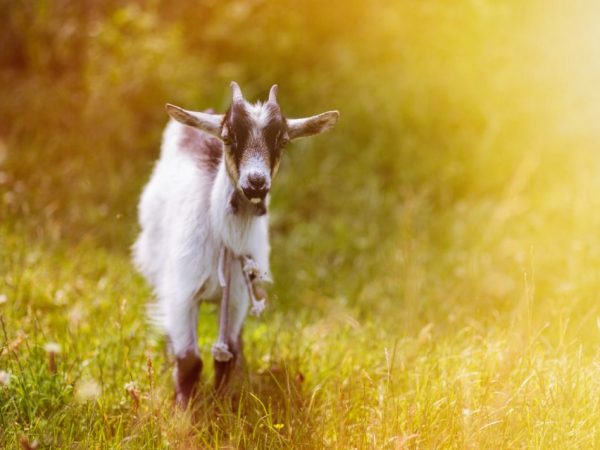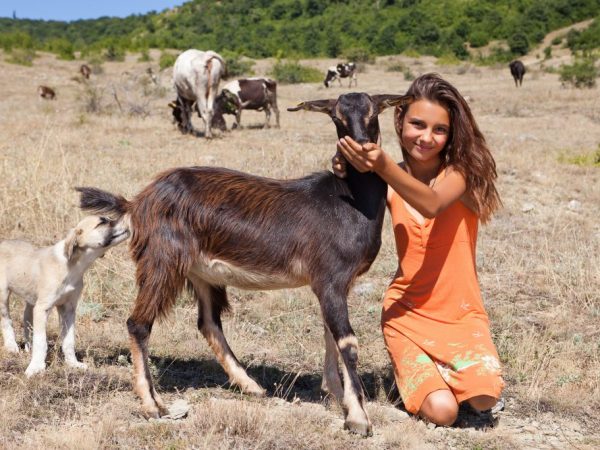Discharge in a goat after lambing is the norm or deviation
Pregnancy and childbirth are processes that greatly overload any living being. During lambing, the female's body experiences maximum stress, and, as a result, requires additional complexes of actions for recovery. Many livestock breeders recommend closely monitoring the mother's health during the birth of offspring. In addition to exhaustion and stress, you can also notice spotting in the goat after lambing.

Discharge in a goat after lambing
Is this the norm or pathology in an artiodactyl? What to do if the discharge is too heavy and the animal weakens?
Fluid secretion in the goat's body
For any living creature, the release of fluid from the body is a natural process. Viscous white grease in goats is a signal that hunting or childbirth is coming soon. It is released from the uterus of the animal during the process of ovulation or waste of water. After lambing, the internal genital organs of artiodactyls are cleaned to be ready for the next pregnancy.
The duration of the cleansing is about three weeks, but this factor can vary depending on how you went through the labor. Usually, the liquid flows out without impurities and a pungent odor. Sometimes an active kid can twitch and damage the internal organs of the female. In this case, the discharge may take longer, and the uterus may become inflamed. If measures are not taken in time, then sepsis may begin and the animal will die.
Bleeding after lambing
Within three hours after giving birth, the afterbirth leaves the female. It contains amniotic fluid and mucus, sometimes with a slight admixture of blood. This is considered normal for a lambing goat. In no case should the afterbirth be pulled out by ourselves - otherwise it may break, and part of it will remain in the uterus. This can lead to suppuration and necrosis.
Usually, bleeding with a normal exit of the placenta stops going a couple of days after childbirth, but if this does not happen and the blood continues to flow abundantly, you should immediately contact your veterinarian.
Causes of heavy bleeding after lambing
Severe spotting is the first sign of difficult labor. The reasons for such discharge may be:
- mechanical injury caused by the cub;
- udder mastitis or cyst on the uterus;
- subinvolution of the uterus.
If the kid is not in the correct position during lambing, then the uterus or vagina may tear.
Cubs are born forward with front legs with the head resting on them. If the fetus goes backwards, or the head is tucked under the back, then most likely it will injure the female. Sometimes the baby can injure the goat's uterine vault, resting on it with crossed legs. In this case, you need to help the cub to take the correct position. To do this, a gloved hand is thoroughly lubricated with petroleum jelly and pushed into the goat's vagina, placing the kid correctly. If the cub goes forward with its hind legs, then a rope is tied to them and gently pulled outward.
Udder mastitis or uterine cysts can also cause bleeding. In the first case, check the milk. If it has bloody discharge, then, most likely, the goat has mastitis or has blown. Observe hygienic milking practices to prevent this disease. Wash the udder with warm water before and after milking, do not keep the cloven-hoofed udder in a draft. This will reduce the risk of contracting such unpleasant diseases. Remember that during and after childbirth, the goat is most vulnerable to lactose mastitis, so prevention should be done in the first months of pregnancy.
Subinvolution is called the flabbiness of the muscle walls and the poor contractility of this organ. A similar pathology occurs if the goat moves too little and is kept in a close enclosure. The muscle tissue of the uterus does not contract, which is why bleeding occurs, and in some cases, the prolapse of internal organs. The second reason for subinvolution may be a large offspring - four or five kids. In this case, the organ stretches too much and cannot regain its original shape. To prevent this, drink the goat before giving birth with preparations containing vitamin A.
Dangerous consequences of profuse bleeding

Keep a close eye on your goat's health
During blood loss, the work of all internal organs is disrupted due to a lack of oxygen and nutrients in the body. Toxins begin to accumulate in the cells of the animal's body, and intoxication occurs. Long-term bleeding is a threat primarily to the nervous system, due to which the goat weakens and may faint. Artiodactyl's blood pressure drops rapidly, pulse and respiration become more frequent. The body temperature of the animal drops greatly due to poor heart function. It is also worth noting that blood loss can be accompanied by painful shock - the goat will worry and not understand what is happening to it.
If the blood is not stopped in time, then the limbs of the animal become cold, breathing is rare, and the muscles relax. General weakness is the main consequence of profuse bleeding. If you do not provide first aid to the goat, the animal will die.
Ways to treat a goat during bleeding
First of all, you should consult with veterinary specialists. If the goat has the first lambing, then it is better to call a doctor at home to take delivery. However, in an emergency, certain medications can be used:
- Oxytotion - one ampoule twice a day, 15 minutes before milking, intramuscularly. This medication aims to improve uterine contractions. Enter within three days.
- Dicinon - one ampoule three times a day intramuscularly. This medicine improves blood clotting and vascular health. Applying also for three days.
- Vikasol - one ampoule twice a day. This drug replaces diet, in the absence of the latter. Enter within three days.
- Bitsilin-3 (300,000 EU) is a mild antibiotic used for prophylactic purposes. Reduces the risk of uterine inflammation in case of poor-quality afterbirth, which is an organic medium for many infections. Apply once after lambing, intramuscularly.
To prepare an injection solution from bicillin, special water for vaccination is required, which can be purchased at any pharmacy. The ampoule is dissolved in 2 ml of the base, and then injected into the muscle of the hind leg. Before injection, the injection site is treated with alcohol. Use only disposable syringes. During vaccinations, do not touch the animal's bone, otherwise inflammation may begin.
In addition to medications, there are also effective folk methods:
- Nettle infusion is a concentrated herbal infusion. You can also feed the stems neat.
- Onion peel decoction - for half a liter of water a handful of onion peels, two tablespoons of sugar and one tea salt. The broth is infused for a day.
- Sugar water or glucose solution - 500 grams of sugar are poured into half a liter of boiled water and given to the animal twice a day.
All these broths are rich primarily in iron and therefore will help fill the lack of this mineral in the goat's body. Such treatment should be carried out if there is no profuse blood loss after lambing, but spotting continues after two weeks. This is considered the first symptom of the inflammatory process of the uterus. Other signs of active inflammation are considered to be a putrid unpleasant odor, cloudy color, fever and general malaise of the animal. The goat may bleat as best it can, asking for help from the owner, or, on the contrary, no longer have the strength to voice. In this case, the animal requires more active treatment than suggested above. Use these drugs in accordance with the instructions:
- Penicillin;
- Streptomycin;
- Cefazolin;
- Lincomycin;
- Tetracycline
Potent antibiotics are also given intramuscularly. The course of treatment is five days, after which the body gets used to the drugs and the medicine should either be replaced or canceled altogether.
Before using these drugs, be sure to consult your veterinarian - these drugs are hard on the body. Be prepared to provide your goat with a special diet to support the liver and kidneys - these organs are primarily affected by antibiotics.
Treatment of blood loss in case of complications
If profuse bleeding for some reason lasts longer, then you should immediately call a doctor - the life of the animal is at stake. First of all, the veterinarian will begin to restore the cardiac activity of the body. To replenish the blood level in the body, the animal is administered the following drugs:
- Ringrer's solution - two hundred ml twice a day;
- Saline solution - two hundred ml twice at knocks;
- Gamavit or ascorbic acid - 1 ml twice a day.
These medications will help restore fluid levels in the body. Worst of all, if the goat refuses to drink - in this case, the cloven-hoofed person is given droppers two or three times a day. If inflammation has begun in the animal's body and the discharge has become purulent, then most likely surgery will be needed. Therefore, it is best to provide treatment to the goat at an early stage of the disease, otherwise the animal may die or be disabled. In case of complications after blood loss, the artiodactyl should be closely observed for at least six months. At this time, try not to consume animal milk and carry out monthly prophylaxis.
So, scanty discharge from a goat after lambing is a natural process of cleansing the body. If a goat has profuse white discharge after childbirth, this may be a sign of imminent heat or the remnant of mucus after childbirth. Heavy bleeding for several days can be a sign of internal injury or inflammation. Monitor the birth to give the animal first aid in case of emergency. Also, for this purpose, it is worth carrying out prophylaxis to replenish the body with vitamin A and iron.


